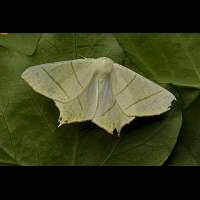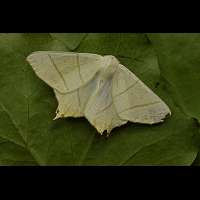Swallow-tailed Moth (Ourapteryx sambucaria)
A big, conspicuous, yellowish moth. The swallow-tail like points of the wings are quite remarkable and have given this moth its name. Easily identified, for there are no similar species. Freshly emerged animals have a lemon colour, but this soon fades into a yellowish white. It is a big species, reaching a wing span of some 50 to 62 mm. Females are bigger than males.
The eggs are deposited in groups on the underside of leaves. They hatch in August. The caterpillars will be long (up to 50 mm), thin and are tapered towards the head. The colour varies from darkbrown to light brown. Some larvae are brownish green. The markings are variable as well and are vague. The caterpillars bear a striking resemblance to a twig. In October the larvae try to find a spot to overwinter. Usually they hide in a crack in the stem of their hostplant. In spring they reappear to complete their development. The caterpillar of the Swallow-tailed Moth feeds during the night. During day time it rests in the well known Geometer way: posing as twig. In spite of its length it is very difficult to spot indeed. By June the larvae abandon the leaves and make a cocoon on the underside of a branch of the foodplant. Even these cocoons are hard to spot, for small pieces of leaves are put into the cocoon. The caterpillars can be found on hawthorn, blackthorn, privet, ivy and other trees and shrubs.
The Swallow-tailed Moth flies in just one generation and is on the wing in June and July mainly. Only flies by night. Is attracted to light, but in varying numbers. Hard to see during the day. Common in England, Wales and Ireland, but a rather local species in Southern Scotland. Common in continental Europe as well, including most northern regions.
A big, conspicuous, yellowish moth. The swallow-tail like points of the wings are quite remarkable and have given this moth its name. Easily identified, for there are no similar species. Freshly emerged animals have a lemon colour, but this soon fades into a yellowish white. It is a big species, reaching a wing span of some 50 to 62 mm. Females are bigger than males.
The eggs are deposited in groups on the underside of leaves. They hatch in August. The caterpillars will be long (up to 50 mm), thin and are tapered towards the head. The colour varies from darkbrown to light brown. Some larvae are brownish green. The markings are variable as well and are vague. The caterpillars bear a striking resemblance to a twig. In October the larvae try to find a spot to overwinter. Usually they hide in a crack in the stem of their hostplant. In spring they reappear to complete their development. The caterpillar of the Swallow-tailed Moth feeds during the night. During day time it rests in the well known Geometer way: posing as twig. In spite of its length it is very difficult to spot indeed. By June the larvae abandon the leaves and make a cocoon on the underside of a branch of the foodplant. Even these cocoons are hard to spot, for small pieces of leaves are put into the cocoon. The caterpillars can be found on hawthorn, blackthorn, privet, ivy and other trees and shrubs.
The Swallow-tailed Moth flies in just one generation and is on the wing in June and July mainly. Only flies by night. Is attracted to light, but in varying numbers. Hard to see during the day. Common in England, Wales and Ireland, but a rather local species in Southern Scotland. Common in continental Europe as well, including most northern regions.





